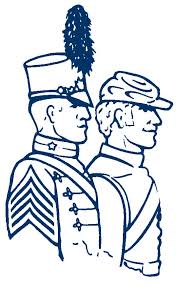The story of ‘The Class that Never Was’ now in four languages across Europe
This article was originally published by The Citadel Newsroom on November 6, 2014.
CHARLESTON, SC – In honor of the 70th Anniversary of The Citadel’s Class of 1944, known as “The Class that Never Was”, and in memory of the members of the classmates who served in or were killed in action in World War II, the college released a special video presentation in 2014 just before D-Day.
Now, that video, which includes rare film footage from campus in the 1940s, is being shown in four languages throughout Europe, thanks to the work of Roger Long who is a member of The Citadel Class of 1989, and members of The Citadel Memorial Europe Foundation. Long is president of the BENELUX Citadel Club, and founder and chairman of The Citadel Memorial Europe Foundation. He lives in Heythuysen, in the Dutch province of Limburg. He is originally from Raleigh, N.C.
“Members of The Citadel Memorial Europe Foundation volunteer in middle schools around the continent. The video about The Class that Never Was is the perfect teaching tool we needed to help honors and memorialize the Citadel men and their allies who died while in the service of their country here in Europe and in North Africa,” Long said.
Long worked with translators to establish subtitled copies of the video in Dutch, French and Italian, to complement the original version in English, enabling Europeans speaking those languages to view the video.
The story is told through the eyes of Timothy Street, a WWII veteran and a member of The Citadel’s Class of 1944, as well as a lifelong resident of Charleston, S.C., where the college has been located since its founding in 1842.
See also: The class where 34 seats remained empty
Street and his classmates didn’t make it to their senior year. With a critical war need for junior officers and second lieutenants, the federal government called Street’s entire class (with the exception of three who could not serve) to war in the summer of their junior year. According to Street, it happened despite a formal objection by the college’s president Gen. Charles P. Summerall who felt the cadets would make better soldiers after they finished their military education.
“They were sent to Europe almost instantly, or at least very quickly, and they had terrible tough times because they were all the youngest grade of officer and they had the roughest duty, and we had, as a class, more fatalities than any other class at The Citadel,” Street recalled.
Street and many of his classmates did return to The Citadel to finish their degrees after serving in the war. More than 6,000 men from The Citadel served during World War II. At least 209 were killed in action or died of wounds. As for the D-Day invasion in France on June 6, 1944, 13 men from The Citadel died on that day or in the months immediately following; at least three of them were members of The Class that Never Was. Graduates of The Citadel have served America in every war since the Mexican War of 1846. Learn about the Class of 1944 by watching the video in English here.
To watch the video with Dutch / Nederlands subtitles click here.
To watch the video with French / Française subtitles click here.
To watch the video with Italian / Italiana subtitles click here.
WHAT IS THE CITADEL MEMORIAL EUROPE ABOUT?
According to Long, there are 47 soldiers from The Citadel interred in and another 9 memorialized at military cemeteries in Europe and North Africa. The remains of more than 60 other Citadel alumni who were killed in action were repatriated back to the US for burial following the end of hostilities. That’s why he started the organization.

Roger Long, ’89, at the grave of James W. Hendon, Jr., Class of 1946, Ardennes American Cemetery near Liege, Belgium
“The Citadel Memorial Europe is the result of my wanting to share the stories of the Citadel Men interred in the WWI and WWII American cemeteries of Europe and North Africa with the people in France, Belgium, Italy and Netherlands who have been caring for their graves, in some cases more than twenty-five years. People who attend The Citadel are special. There is a bond between us that runs across the generations,” Long explained. “Although we may have never met each other – we know each other. The experience, values and character which makes them Citadel Men is unique and at the heart of their story.
The adoption of graves at the American cemeteries in Europe goes all the way back to 1945 according to Long’s research. “Adopters promise to visit and place flowers on the grave at least once a year. Recently we received from a Dutch family a copy of the original grave adoption certificate, dated 1946, of Edward G. Cherry, ’46, who is interred at the Netherlands American Cemetery. Making these connections and building bridges between the past and the present is special. I have also been blessed to have contact with family members of the men. Their sacrifice is humbling, and, as a naturalized Dutch citizen (I have dual-nationality) I am proud to be able to explain to them how well their loved one is being cared for by my fellow Europeans who have never forgotten.”
About The Citadel
For seven consecutive years, The Citadel has been recognized by U.S. News & World Report as the top public college in the south for institutions granting up to a master’s degree. The Citadel’s mission is to achieve excellence in the education and development of principled leaders through the core values of honor, duty, and respect.
Contact: Kim Keelor, The Citadel , +1 (843) 953-2155, kkeelor@citadel.edu


